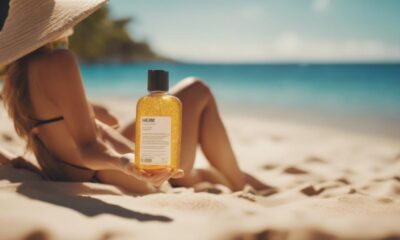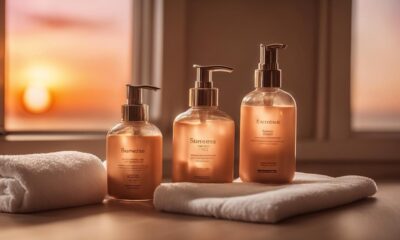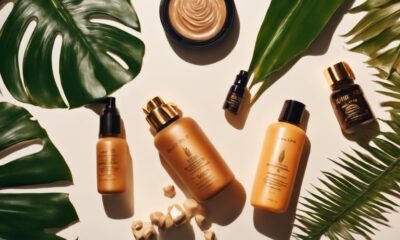Tanned Skin
Unraveling Post-Tanning Itch: What's Happening
Get to the root of post-tanning itch and discover simple solutions to keep your skin glowing without the irritation!
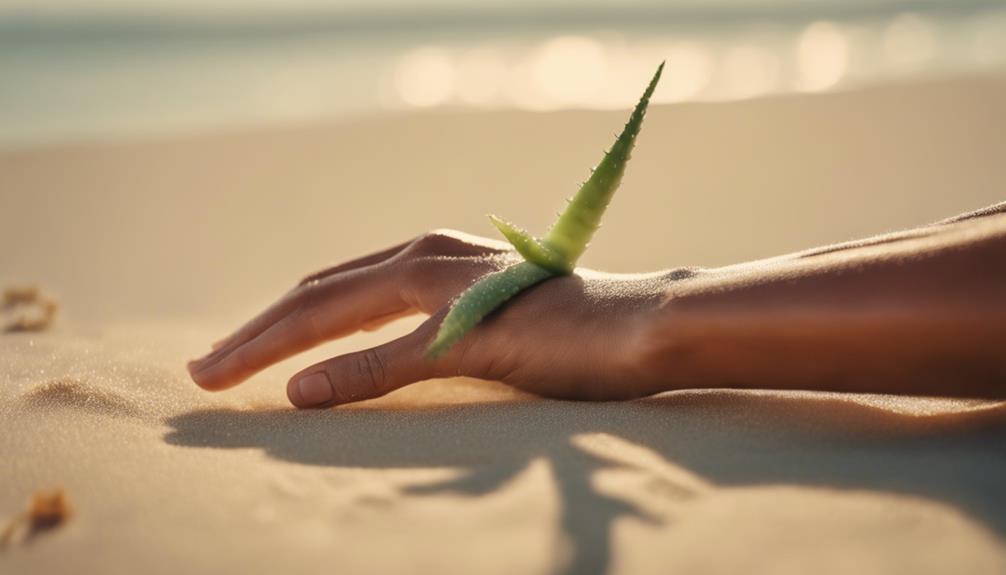
So, you've just tanned, and now your skin's itching like crazy? That's your skin's way of reacting to all that sun (or tanning bed) exposure! When you tan, your skin loses moisture and can become irritated, leading to an itch-fest. Sometimes, it's the tanning lotion's fault, especially if it has allergens or funky fragrances that don't agree with your skin. But don't worry! There are ways to help soothe that pesky itch, like using moisturizers or aloe vera. Keep exploring, and you'll find out how to keep that gorgeous glow without the scratchy side effects!
Key Takeaways
- Post-tanning itch is often caused by excessive UV exposure leading to skin dryness and irritation.
- Tanning lotions may contain allergens or irritants, triggering redness and rashes on the skin.
- Itchiness signals skin distress, indicating a need for hydration and care after tanning.
- Using moisturizers and cool showers can help soothe and alleviate post-tanning itch.
Causes of Post-Tanning Itch
Post-tanning itch often crops up due to your skin's reaction to excessive UV exposure, leading to dryness and irritation. When you bask under those sun rays or tanning lamps, your skin can get a bit too excited, causing it to lose moisture.
This dryness triggers an SOS response, making your skin feel itchy and uncomfortable. Plus, if you're using tanning lotions, you might be dealing with some pesky allergens in the mix! Fragrances and preservatives can cause your skin to rebel, resulting in redness and rashes.
Prevention Techniques for Tanning

To prevent post-tanning itch, start with short sessions to gradually build your skin's tolerance to UV exposure. Think of it like training for a marathon—you wouldn't sprint right out the door, right?
Use a good moisturizer before and after tanning to keep your skin hydrated. This will help fend off that pesky dryness that leads to itching.
Choosing hypoallergenic tanning lotions can also keep allergic reactions at bay; nobody wants to look like a tomato! If you start feeling uncomfortable, take a break; your skin will thank you.
And hey, self-tanning products are a fantastic option too! They offer that sun-kissed glow without the UV drama. Remember, your skin deserves some TLC!
Recognizing Tanning Bed Rash

After a tanning session, you should be on the lookout for signs of a tanning bed rash, which often appears as raised bumps or redness on your skin.
You might feel a little itchy or irritated, and that's your skin's way of saying, “Hey, something's up!” If you notice these symptoms, don't panic; it's your body reacting to the UV rays or even some ingredients in your tanning lotion.
Remember, if it sticks around for more than a couple of days, it's time to call in the pros. And if you see any oozing or unusual discharge, don't wait—get to a doctor!
Your skin deserves the best care, so keep an eye out and stay informed!
Remedies for Itchy Skin

For soothing that pesky itch, consider applying aloe vera or a fragrance-free moisturizer to your skin. These options help hydrate and cool your irritated skin. You might also try products with hyaluronic acid or oatmeal for extra relief. Taking cool showers can be a game changer, too—hot water might only make things worse!
Here's a quick reference table for your convenience:
| Remedy | Benefits |
|---|---|
| Aloe Vera | Cooling, soothing, and hydrating |
| Fragrance-Free Moisturizer | Hydrates without irritation |
| Oatmeal Products | Soothes and calms itchy skin |
| Cool Showers | Reduces inflammation and discomfort |
Don't forget to chill your moisturizer before applying it for an even more invigorating feel!
When to Consult a Doctor

Knowing when to consult a doctor can prevent complications from persistent itching or rash after tanning. If your itchiness sticks around for several days or gets worse, it's time to call in the pros.
Excessive scratching might lead to infections, and nobody wants that! Also, keep an eye out for unusual symptoms like discolored pus or fever—those are definite reasons to seek immediate help.
If you've got a family history of skin cancer, it's especially important to be cautious about any strange skin reactions. Sometimes, home remedies just won't cut it, and you'll need a prescription treatment.
Frequently Asked Questions
Can Certain Skin Types Be More Prone to Post-Tanning Itch?
Yes, certain skin types can be more prone to post-tanning itch. If you have sensitive or dry skin, you're likely to experience irritation and discomfort after tanning, so take extra precautions to protect your skin.
Do Indoor Tanning Beds Cause More Irritation Than Outdoor Tanning?
Indoor tanning beds can indeed cause more irritation than outdoor tanning. Their concentrated UV exposure often leads to quicker skin dryness and irritation. You should consider using moisturizers and taking breaks to help minimize discomfort.
Are There Specific Ingredients in Lotions That Aggravate Itchiness?
Imagine a garden thriving under the sun's warmth. However, certain weeds—like fragrances and preservatives—can choke your skin's comfort. If you notice itchiness, check ingredients; they might be the culprits causing irritation.
How Long Does Post-Tanning Itch Typically Last?
Post-tanning itch usually lasts a few hours to a couple of days. If it persists longer, consider evaluating your tanning process or products, as prolonged discomfort might indicate an adverse reaction or skin sensitivity.
Can Diet Influence Skin Reactions After Tanning?
You might be surprised, but your diet can impact skin reactions after tanning. Foods rich in antioxidants can help soothe inflammation, while processed foods might worsen irritation. Pay attention to what you eat for healthier skin!
Conclusion
So, there you have it! Post-tanning itchiness can be a real pain, like having an annoying mosquito buzzing in your ear. But fear not, there are some remedies to help soothe the itchiness, such as applying aloe vera or a gentle moisturizer. Some people also find relief by taking an oatmeal bath or using a cooling gel. And if you’re also wondering about the mystery of untanned feet, it could be due to the thickness of the skin on your feet, which may make it harder for the tanning lotion to penetrate.
But with some simple prevention tips and soothing remedies, you can keep your skin happy and healthy.
Remember, if the itch sticks around or gets worse, don't hesitate to chat with a doctor—they're like your skin's personal superhero!
Enjoy that sun-kissed glow while keeping your skin in top shape.
Happy tanning!
Tanned Skin
Unlocking the Secret to a Deeper Tan
Harness the power of tanning strategies to achieve a deeper glow—discover the essential tips that will transform your sunbathing experience!

Revealing the secret to a deeper tan is all about strategy, not just sunbathing! First, know your skin type—fair skin needs more care, while darker skin can handle a bit more UV. Start with 3-5 initial tanning sessions to establish a base, spacing them out to avoid burns. Use tanning lotions with L-tyrosine to boost melanin and keep your skin hydrated. Don't forget those stylish goggles; your eyes need love too! Finally, if you hit a tanning plateau, switch it up. With the right techniques, you're on the path to that golden glow. Ready for more tips?
Key Takeaways
- Identify your skin type to tailor your tanning sessions and avoid burns, ensuring optimal results for a deeper tan.
- Use tanning lotions with L-tyrosine to boost melanin production and enhance your tanning efficiency.
- Track your sessions and maintain a routine of 3-5 initial visits, followed by touch-ups every few weeks for consistency.
- Stay hydrated and moisturize post-session to prevent dry skin, which can hinder tanning results by reflecting light.
Tanning Sessions and Frequency
When you start your tanning journey, aim for 3-5 initial sessions to build a solid base tan. Think of this as laying the foundation for your golden glow!
If you've got fair skin, you might need a few extra sessions, but don't worry. After those first few visits, plan for 3-4 weekly touch-ups to keep that sun-kissed look alive.
You'll typically see some color peeking through after just a few sessions, but patience is key. Remember to let your skin breathe; wait at least 48 hours between sessions to avoid overexposure.
Consistency is important, so keep track of your visits, and soon you'll be strutting around with the tan of your dreams!
Understanding Skin Types

Identifying your skin type is essential for effective tanning and preventing burns.
You've got to know if you're fair, medium, or dark because that'll guide your tanning journey. Fair skin might burn faster, while darker skin types can usually handle more UV rays without turning into a lobster.
Understanding your melanin levels acts like a built-in sunblock, helping you tan safely. You'll want to adjust your tanning sessions based on your skin type, so you don't end up looking like a tomato!
Always wear protective eyewear, too, because squinting isn't a good look. By being smart about your skin type, you can achieve that golden glow while keeping your skin happy and healthy.
Now, let's get glowing!
Tanning Lotions and Accelerators

Tanning lotions and accelerators play an essential role in enhancing your glow while protecting your skin during tanning sessions.
When you pick the right lotion, you're not just slathering on some cream; you're giving your skin a boost! Look for products with moisturizers and SPF, as they hydrate and guard against sun damage.
Applying lotion evenly is key for that flawless tan, so don't skip any spots—your skin will thank you later! Plus, those lotions with L-tyrosine can really ramp up melanin production, helping you achieve that golden hue faster.
After your tanning session, remember to moisturize again to keep your tan looking fresh and vibrant. It's the secret sauce to a long-lasting, beautiful tan!
Recognizing Tanning Plateaus

Recognizing tanning plateaus is key to understanding when your skin has reached its maximum melanin production and needs adjustments to continue deepening your tan. When you hit this plateau, don't panic!
Here are three fun strategies to keep your glow going:
- Switch it Up: Try a different tanning bed. Different UV rays can kickstart your melanin production again.
- Take a Break: Give your skin a little rest. A short break can help avoid overexposure and keep your skin healthy.
- Stay Hydrated: Drink plenty of water. Dry skin reflects light instead of soaking it up, so keep that skin moist!
Keep these tips in mind, and you'll be back on the path to that deep, golden tan in no time!
Safety Practices for Tanning

Prioritizing safety is essential to enjoying a healthy tanning experience without risking skin damage.
First, know your skin type—this helps you avoid painful burns. Make sure you wear protective eyewear; your eyes deserve better than UV rays!
When you start tanning, begin with shorter sessions and gradually increase the time as your skin adjusts. Remember, patience is key; no one wants to look like a lobster!
Always use quality tanning lotions with SPF; they hydrate your skin while helping you achieve that golden glow.
And don't forget to space out your sessions, allowing at least 48 hours between them.
Common Tanning Myths

Many people fall for common tanning myths that can lead to unsafe practices and unrealistic expectations. Let's bust a few of these myths together!
- Base Tan Equals Burn Protection: Some think getting a base tan prevents burns. Nope! It only offers minimal protection, like SPF 3.
- Tanning Beds Are Safer Than the Sun: Many believe tanning beds are a risk-free way to tan. Wrong again! They expose you to harmful UV rays.
- Dark Skin Doesn't Need Protection: Just because you have a deeper skin tone doesn't mean you're immune to sun damage. Everyone needs protection!
Trending Tanning Products

When it comes to achieving the perfect tan, staying updated on trending tanning products can make a significant difference in your results. You'll want to check out the latest tanning lotions that not only boost melanin production but also keep your skin hydrated.
Look for products with L-tyrosine, a fancy ingredient that helps you tan faster. And don't forget the tan accelerators—they're like your new best friends for a golden glow!
To protect your eyes and skin, grab some stylish tanning goggles and maybe a cute face cover for those extra sunbed sessions.
With the right products, you'll be strutting your stuff with that deep, sun-kissed tan in no time, and your friends might just be a little jealous!
Frequently Asked Questions
Can I Tan if I Have a Sunburn?
You shouldn't tan with a sunburn. Your skin needs time to heal, and tanning can worsen the burn, leading to more damage. Focus on soothing your skin before resuming any tanning sessions safely.
Does Diet Influence My Tanning Results?
Yes, your diet does influence tanning results. Consuming foods rich in antioxidants, vitamins A, C, and E can enhance skin health and melanin production, helping you achieve a more radiant and longer-lasting tan. Stay nourished!
How Long Does a Tan Typically Last?
A tan typically lasts about 7 to 10 days, depending on your skin type and care. To extend it, moisturize regularly and avoid exfoliating too much. Staying hydrated also helps maintain that golden glow.
Can I Use Self-Tanner After Tanning Sessions?
Think of your skin as a canvas. Yes, you can use self-tanner after tanning sessions, but wait until your tan settles. This way, you'll achieve a richer, more even glow without streaks or patches.
Will Tanning Affect My Skincare Products' Effectiveness?
Tanning can temporarily reduce your skincare products' effectiveness, as UV exposure may cause skin barrier changes. To maintain benefits, apply your products after tanning sessions and allow them time to absorb before further exposure.
Conclusion
So, there you have it!
With a little patience and the right products, you can achieve that dazzling, deep tan you've always wanted.
Remember, it's all about scheduling your sessions, selecting suitable lotions, and staying safe under the sun.
Don't fall for common tanning myths—knowledge is power!
So, embrace your unique skin type, and let your tanning journey be a fun and fabulous one.
Get ready to glow, and show off that stunning sun-kissed skin!
Tanned Skin
Revitalize Your Skin After Tanning
How to rejuvenate your skin after tanning and maintain that sun-kissed glow—discover essential tips that will leave you wanting more!
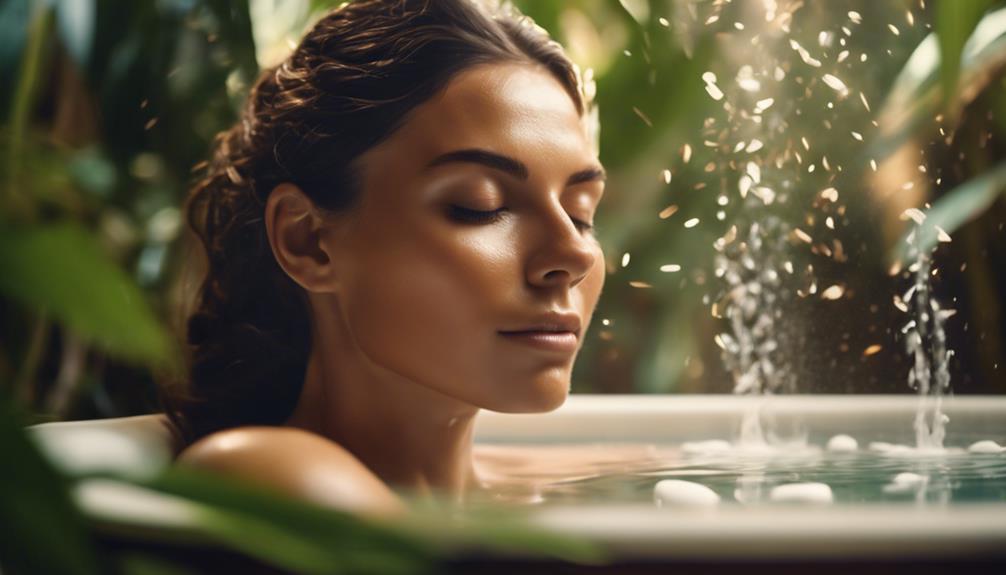
Revitalizing your skin after tanning is super important for keeping it looking fresh and fabulous! First, hop in the shower and slather on a thick moisturizer to lock in moisture. Don't forget sunscreen with SPF 30 or higher to protect against those sneaky UV rays—reapply every two hours! Hydrate like a champ by guzzling water and munch on fruits and nuts to nourish your skin from the inside out. Oh, and keep an eye on skin reactions; if things get itchy, a good aloe vera gel can work wonders. Stick around, and you'll find even more helpful tips!
Key Takeaways
- Apply a rich post-tan moisturizer immediately after showering to replenish and lock in skin moisture.
- Use sunscreen with SPF 30 or higher, reapplying every two hours to protect your skin from UV damage.
- Incorporate antioxidant-rich products and snacks like berries and nuts to nourish and aid skin recovery after tanning.
- Stay hydrated by drinking plenty of water daily to maintain skin plumpness and overall health.
Post-Tanning Skin Care Essentials
After tanning, your skin craves hydration and nourishment to maintain that sun-kissed glow.
First things first, slather on a post-tan moisturizer right after showering—it helps lock in moisture and keeps your skin feeling soft.
Don't forget your sunscreen! Grab one with SPF 30 or higher, even if you're just stepping outside for a quick errand. Reapply it every two hours, and keep sipping that water to hydrate from the inside out.
To avoid looking like a patchy potato, exfoliate gently 1-2 times a week.
And hey, munching on fruits and omega-3s can work wonders for your skin too!
It's all about taking care of yourself so that radiant tan lasts longer and looks fabulous!
Effective Hydration Techniques

To keep your skin glowing and healthy post-tanning, prioritize deep hydration by using products rich in hyaluronic acid and aloe vera.
These ingredients pull moisture into your skin, making it feel revitalized and rejuvenated. Plus, who doesn't love that soft, bouncy feeling?
Here are some effective hydration techniques you can try:
- Apply a thick layer of moisturizer right after showering.
- Use a hydrating serum before your moisturizer for an extra boost.
- Keep a bottle of aloe vera gel in your fridge for an invigorating cool-down.
- Don't forget to drink plenty of water throughout the day.
With these tips, you'll keep your skin happy and hydrated!
Importance of Sun Protection
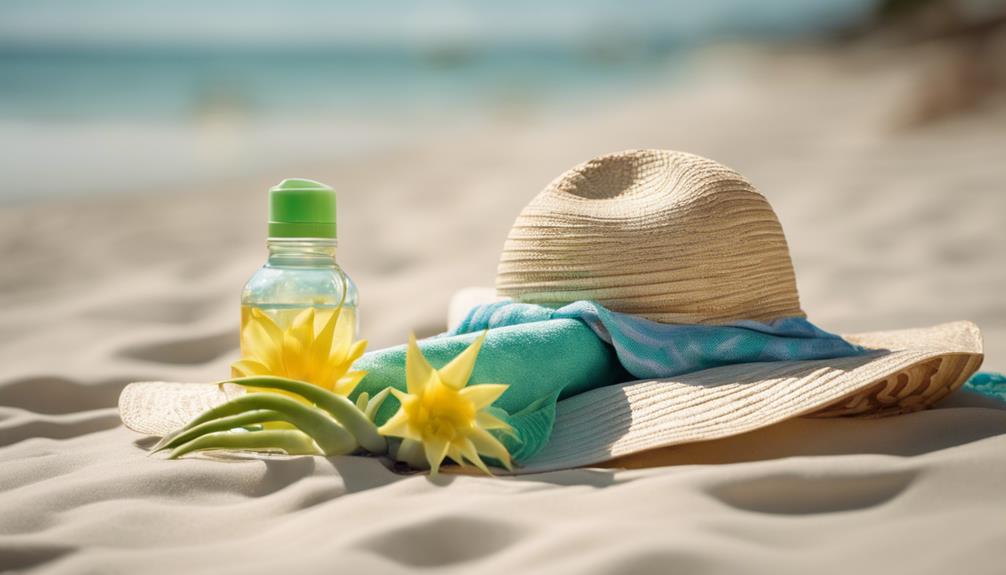
Sun protection is essential for keeping your skin healthy and preserving that beautiful tan you've worked hard for. You wouldn't want your glow to fade away, right? Applying sunscreen daily, even when you're indoors or it's cloudy, can make a huge difference. Check out the quick tips below to stay sun-safe!
| Tip | Description |
|---|---|
| Use SPF 30 or higher | Protects your skin from harmful rays. |
| Reapply every 2 hours | Keep that protection going all day! |
| Wear protective eyewear | Shields your eyes from UV damage. |
| Stay hydrated | Drink plenty of water for skin health! |
Nourishing Your Skin
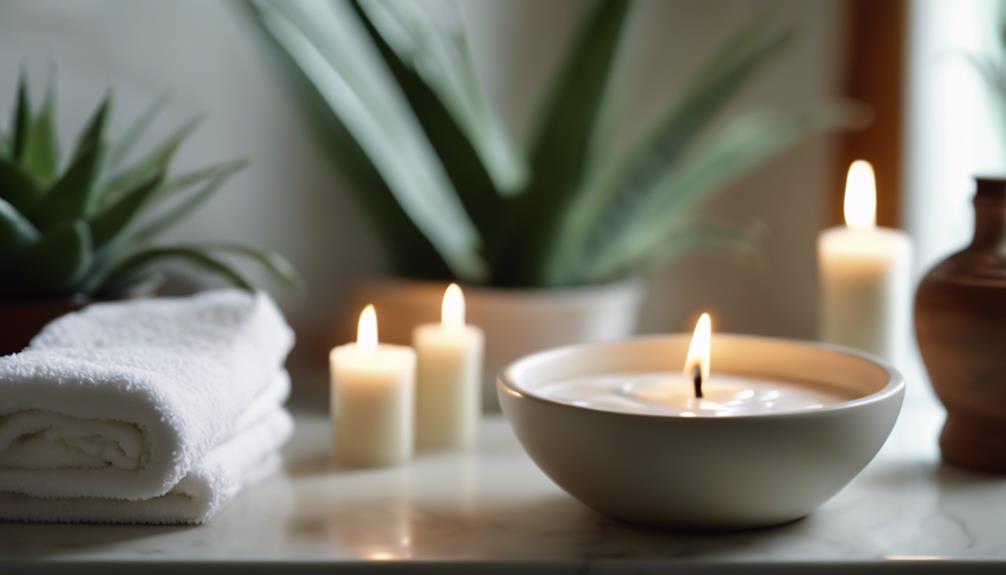
Nourish your skin with antioxidant-rich products that support recovery and maintain a radiant glow after tanning. Your skin's been through a lot, and it deserves some TLC! Here's how to give it the love it needs:
Look for lotions packed with vitamins C and E to repair damage.
Consider aloe vera gels to cool and soothe any irritation.
Snack on berries and nuts—your skin will thank you from the inside out!
Use a gentle exfoliant once or twice a week to keep your skin smooth.
Don't forget to hydrate! Water helps keep your skin plump and happy.
Treat your skin like the superstar it is, and you'll rock that tan with confidence!
Monitoring Skin Reactions
Keeping an eye on your skin's reactions after tanning is important for ensuring it stays healthy and radiant. You might notice some redness or itching, which can happen after a tanning session. If that occurs, don't panic! Just grab your favorite moisturizer and apply it right away to soothe your skin.
But if those pesky reactions stick around, it might be time to consult a dermatologist—better safe than sorry! Remember, your skin's health is key to enjoying that sun-kissed glow. So, stay aware and give your skin the love it deserves.
After all, nobody wants to trade a radiant tan for a red, irritated mess. Keep monitoring, and your skin will thank you with a beautiful, lasting glow!
Tanning Bed Alternatives
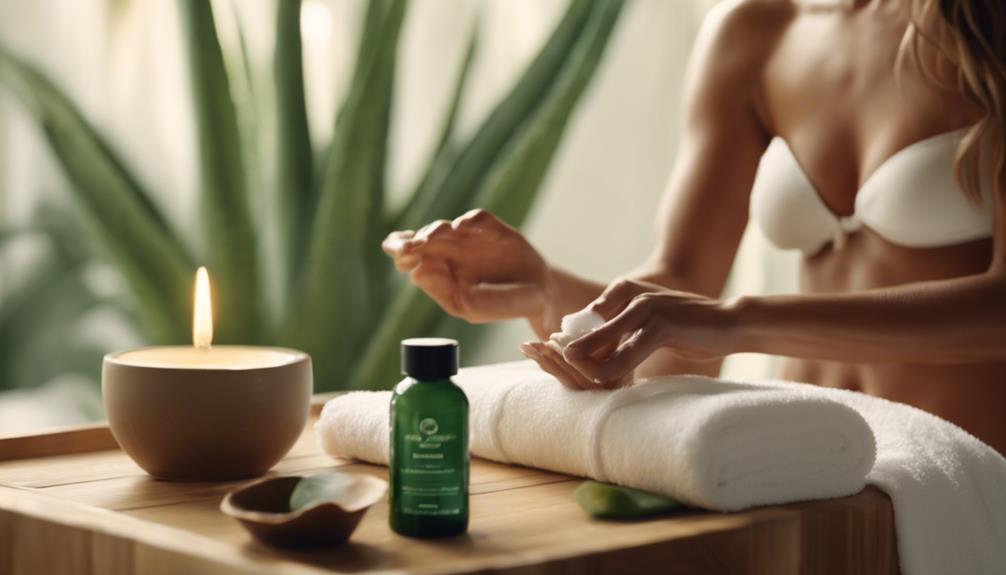
Many people often seek safer alternatives to tanning beds for achieving that coveted sun-kissed glow without the associated risks. Luckily, there are several options that can give you that bronzed look without baking under harmful UV rays.
Here are some popular tanning bed alternatives to contemplate:
- Self-tanning lotions: Apply these for a gradual tan that develops over time.
- Spray tans: Quick and easy, they provide an instant glow with no waiting!
- Tanning oils: Some contain natural bronzers for a subtle glow.
- Bronzing powders: Perfect for a temporary touch-up before an event.
With these alternatives, you can enjoy a beautiful tan while keeping your skin healthy. Who knew looking good could be so easy?
Community Insights on Tanning

Exploring tanning bed alternatives opens up discussions within the community about safer tanning practices and personal experiences that can guide others in their quest for a golden glow. These alternatives not only promote healthier options but also raise awareness about the potential risks associated with traditional tanning methods. Recognizing tanning bed warning signs, such as premature aging and an increased risk of skin cancer, is essential in making informed decisions about sunless tanning. By sharing stories and recommendations, individuals can empower others to achieve their desired look without compromising their health.
You might find that many folks share tips on achieving that sun-kissed look without the risks of tanning beds. They often talk about their favorite self-tanners or sunless options, and how much they love the glow without the UV exposure.
Plus, you'll hear stories about mishaps and successes that make you chuckle, like the infamous orange streaks! Engaging in these conversations not only helps you learn but also connects you with others who share your tanning journey.
Frequently Asked Questions
How Long Does a Tan Typically Last After Tanning?
A tan typically lasts about 7 to 10 days, depending on your skin type and aftercare. To extend it, hydrate your skin regularly and avoid harsh exfoliation, which can accelerate fading.
Can I Use Regular Lotion Instead of Post-Tan Moisturizer?
You can use regular lotion, but it's best to opt for a post-tan moisturizer. These products are designed to hydrate and soothe your skin effectively, ensuring better results and longer-lasting color.
What Are the Signs of Over-Tanning to Watch For?
When over-tanning, you'll notice signs like redness, peeling, or excessive dryness. Your skin might feel itchy or sensitive. If these symptoms appear, it's essential to moisturize and take a break from tanning to allow recovery.
Are There Any Foods That Enhance Tanning Results?
Yes, certain foods can enhance tanning results. Incorporate carrots, sweet potatoes, and tomatoes into your diet; their high beta-carotene content boosts your skin's natural glow. Hydration and omega-3s also support a radiant complexion.
How Often Should I Tan for Optimal Results?
Imagine basking in the sun, your skin glowing golden. For ideal results, tan 1-2 times a week, allowing your skin to recover in between sessions. Listen to your body's signals and adjust as needed.
Conclusion
So, you've tanned and now it's time to pamper your skin!
Remember, keeping that gorgeous glow isn't just a one-and-done deal; it needs a little TLC. Hydrate, protect, and nourish to keep your skin looking its best.
But wait, what happens if you don't? You might end up with a patchy tan or, yikes, sun damage!
Don't let that happen to you. Stick to these tips, and you'll be flaunting that bronzed beauty with confidence!
Tanned Skin
Tanning Bed Overuse: Spot the Warning Signs
Get informed about the warning signs of tanning bed overuse and learn how to protect your skin before it's too late!

If you're using tanning beds too much, watch out for some telltale signs! If your skin feels extra sensitive, red, or itchy, that's your body waving a little flag! Also, dryness and peeling aren't exactly signs of a beach day; they mean it's time to take a break. Keep an eye on any moles or spots—changes in color or size are worth mentioning to a doctor. And don't forget your eyes; gritty or red eyes after tanning could mean trouble. So, be smart about your glow, and stick around to find out how to keep your skin safe!
Key Takeaways
- Look for unusual sensitivity, redness, or itchiness as early warning signs of skin damage from tanning bed overuse.
- Monitor for dryness or peeling skin, indicating potential overexposure to UV rays.
- Be aware of new freckles or changes in existing moles, which could signal skin cancer risk.
- Protect your eyes with goggles to prevent irritation and long-term damage from UV exposure during tanning sessions.
Signs of Skin Damage
When you notice unusual sensitivity, redness, or itchiness on your skin, it's a clear sign that you may be experiencing damage from tanning bed overuse. Your skin's like a delicate flower, and too much sun can make it wilt!
If you see dryness or peeling, that's another red flag waving at you. Itchy rashes can pop up after those tanning sessions, signaling that you've crossed the line into excessive UV exposure.
Don't ignore these signs; they might seem minor now, but they could lead to serious issues later. Persistent redness and itchiness aren't just annoying; they mean your skin's in distress. So, listen to your skin—it's trying to tell you something important before things get really serious!
Effects on Skin Aging
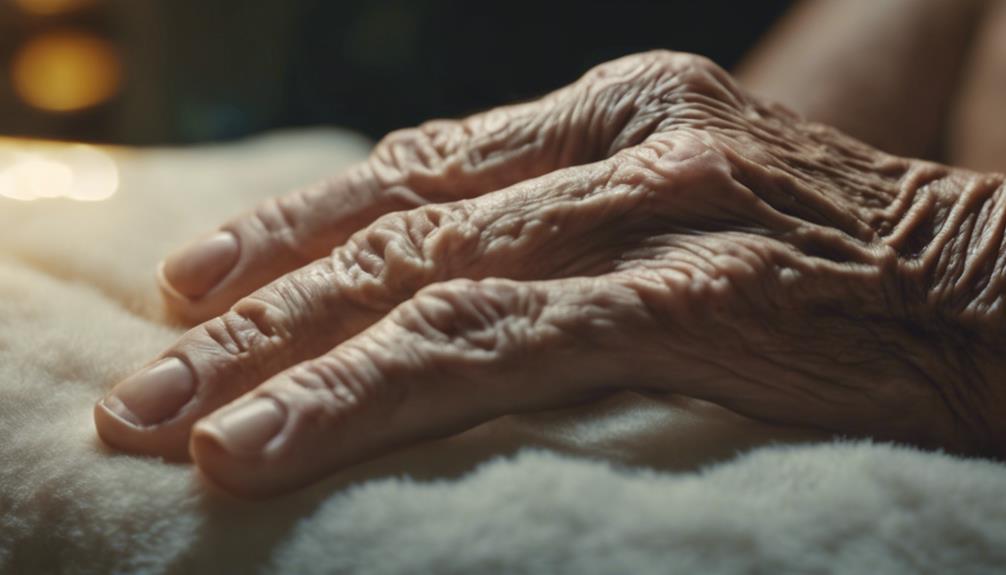
Ignoring the signs of skin damage can lead to accelerated aging, as frequent tanning beds break down collagen and elastin, resulting in premature wrinkles and sagging. Prolonged exposure to harmful UV rays may also increase the risk of dark spots and uneven skin tone, further compromising your skin’s health and appearance. To protect your skin, it’s crucial to educate yourself on chest tanning mistakes to avoid, such as neglecting sunscreen or failing to moisturize regularly. Taking proactive steps can help preserve your skin’s youthful look and minimize long-term damage.
You might think that a bronzed glow makes you look younger, but the truth is, it can actually age you faster! Each time you expose your skin to those harsh UV rays, you're inviting fine lines, uneven skin tone, and a leathery texture to the party. Yikes!
Your skin deserves better than that. Instead of chasing that golden hue, consider embracing your natural beauty or trying safer alternatives like self-tanners.
Monitoring Moles and Spots
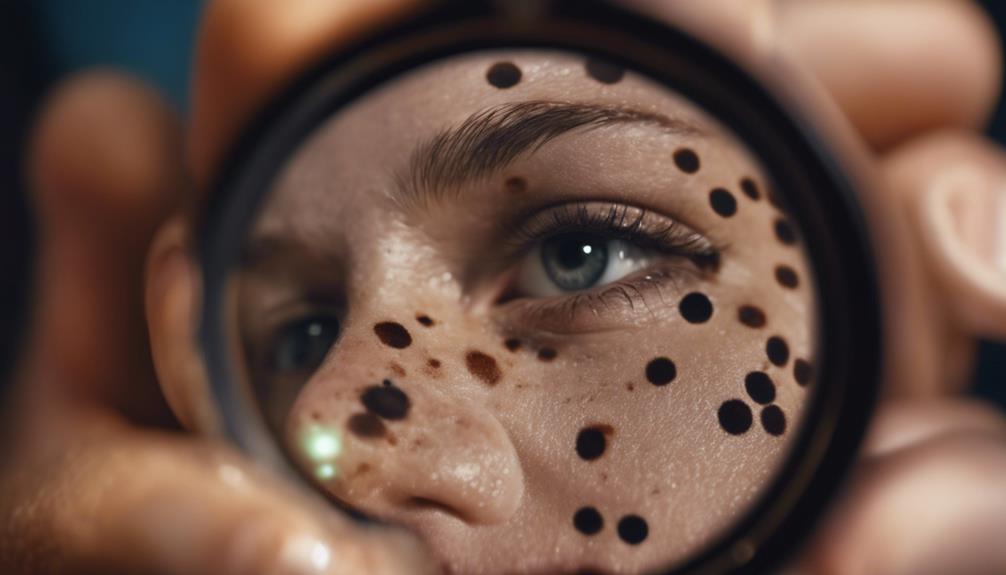
Regularly checking your moles and skin spots is essential for spotting potential signs of skin cancer early on. Think of it as a little skin detective work!
Look for changes in color, size, or shape. If you notice a mole that's growing faster than your favorite plant, it's time to get it checked out. New freckles popping up after those tanning sessions? Keep an eye on them. You want your skin to be happy, not stressed!
Remember, moles with jagged edges or weird colors are like warning lights on your car—don't ignore them! By staying vigilant, you can catch issues before they escalate.
After all, your skin deserves all the TLC it can get!
Eye Irritation Risks

If you experience gritty or red eyes after a tanning session, it could signal potential UV overexposure that warrants immediate attention. You might think, “It's just a little irritation,” but ignoring those warning signs can lead to serious eye problems.
Protecting your peepers is super important! Always wear protective goggles while tanning, or you risk facing issues like photokeratitis, which feels like having sand in your eyes. Ouch!
Plus, over time, too much UV exposure can increase your chances of developing cataracts and even macular degeneration. So, the next time you hit that tanning bed, remember to shield your eyes, because you want your vision to last as long as your glow!
Keep those eyes happy and healthy!
Health Risks and Prevention
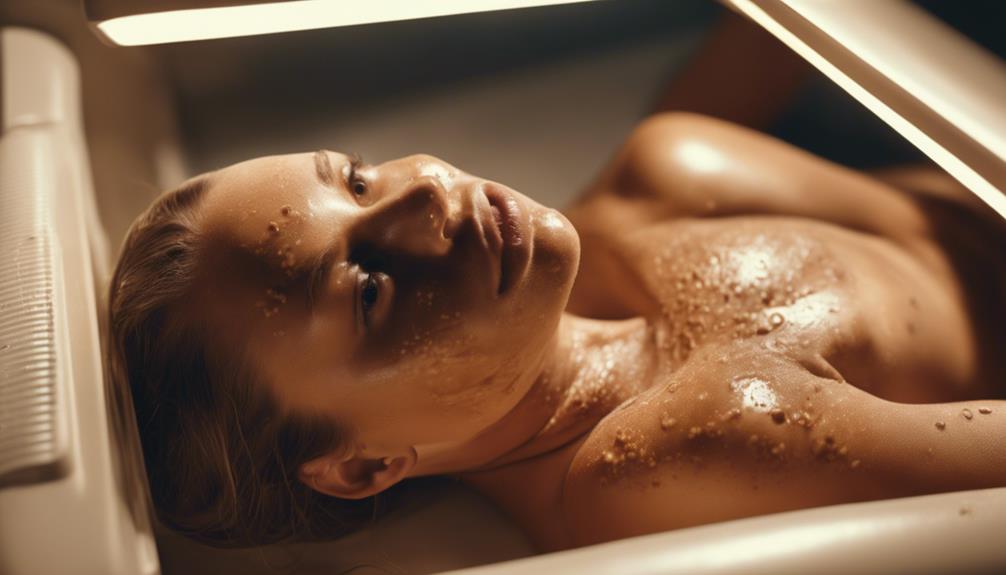
Excessive tanning bed use greatly increases your risk of developing skin cancers, including melanoma, especially if you start before age 35. Yikes! You definitely don't want that.
Here are some quick tips to help you stay safe:
- Use tanning goggles to protect your eyes from harmful rays.
- Limit tanning sessions to reduce overall UV exposure.
Frequently Asked Questions
How Often Should I Use Tanning Beds Safely?
You should limit tanning bed use to once every two weeks for safe exposure. Always monitor your skin's reaction, and consider alternatives like self-tanners to achieve a bronzed look without the risks of UV damage.
What Are the Benefits of Natural Sun Exposure Vs. Tanning Beds?
Natural sun exposure provides vitamin D, boosts mood, and promotes healthier skin without the risks associated with tanning beds. You'll enjoy a more balanced and safer approach to achieving that sun-kissed glow while protecting your skin.
Can Tanning Beds Cause Hair Damage or Changes?
Using tanning beds is like playing with fire; it can scorch your hair. UV exposure might dry it out, leading to brittleness and color changes. Protect your locks by limiting tanning sessions and using proper hair care.
Are There Specific Skin Types More at Risk From Tanning?
Yes, certain skin types are more at risk from tanning. Fair-skinned individuals, those with freckles, or a history of sunburns face higher chances of damage. Always consider your skin type before exposing yourself to UV rays.
What Are the Best Alternatives to Achieve a Tan Safely?
Getting a tan naturally is like basking in the sun's warm embrace. Try self-tanners, bronzing lotions, or tinted moisturizers for a sun-kissed glow without UV risks. You'll achieve a beautiful tan safely and effectively!
Conclusion
So, before you dive headfirst into that tanning bed like it's a giant pool of liquid sunshine, remember to listen to your skin!
If it starts throwing tantrums with redness or itchiness, it's waving a big red flag. Protect yourself from those sneaky skin villains and keep an eye on any weird moles.
Opt for safer alternatives, like self-tanners or bronzers, and keep your skin happy, healthy, and glowing without the risks!
Your skin will thank you!
-

 Vetted6 months ago
Vetted6 months ago15 Best Tanning Accelerators for a Sun-Kissed Glow This Summer
-
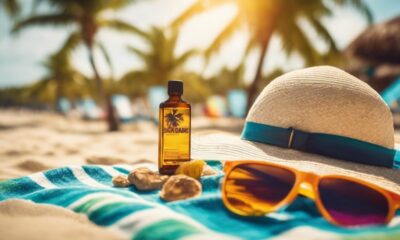
 Vetted6 months ago
Vetted6 months ago15 Best Tanning Oils for a Perfect Sun-Kissed Glow in 2025
-

 Vetted6 months ago
Vetted6 months ago15 Best Sun Tanning Products for a Gorgeous Glow This Summer
-

 Sun Protection6 months ago
Sun Protection6 months agoHow to Protect Your Skin Without Staying Indoors All Day
-

 Sun Protection6 months ago
Sun Protection6 months ago10 Sun Protection Myths Debunked!
-

 Sun Protection6 months ago
Sun Protection6 months agoThe Ultimate Guide to Sun Protection for Every Season
-
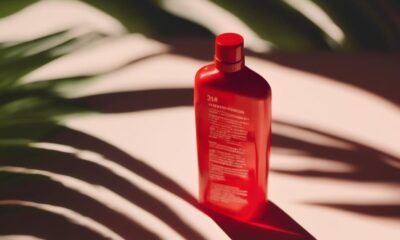
 Sun Protection6 months ago
Sun Protection6 months agoWhat Dermatologists Wish You Knew About Sunburns
-
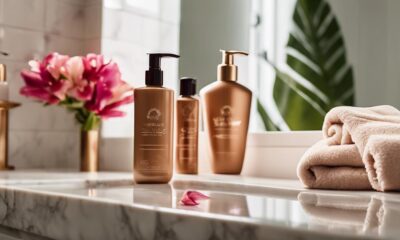
 Vetted6 months ago
Vetted6 months ago15 Best Fake Tanning Lotions for a Sun-Kissed Glow All Year Round








